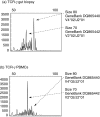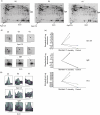Proteins specifically hyperexpressed in a coeliac disease patient with aberrant T cells
- PMID: 17335557
- PMCID: PMC1941938
- DOI: 10.1111/j.1365-2249.2007.03348.x
Proteins specifically hyperexpressed in a coeliac disease patient with aberrant T cells
Abstract
An aberrant T cell population is the basis for diagnosis of refractory coeliac disease and determines the risk of enteropathy-associated T cell lymphoma. This disease is serious with a poor survival. Pathogenetic mechanisms sustaining aberrant T cell proliferation remain unknown. Recently, alemtuzumab has been proposed as a promising new approach to treat these patients. Only few single cases have been tested at present; nevertheless, in all the cases a clinical improvement was observed. However, whether intraepithelial lymphocytes have been targeted effectively by alemtuzumab is still debated. This study reports, using two-dimensional difference gel electrophoresis (2D DIGE), hyperexpressed proteins associated specifically with aberrant T cells found in a patient with coeliac disease by comparison of the protein expression of this sample with that of patients with coeliac disease and polyclonal T cells or with control subjects. The data demonstrated a significantly higher expression of IgM, apolipoprotein C-III and Charcot-Leyden crystal proteins in a duodenal biopsy specimen of the patient with clonal T cells compared with that of other patients. These preliminary results allow hypothesizing different clinical effects of alemtuzumab in patients with coeliac disease and aberrant T cell proliferation, because as well as the probable effect on T cells, alemtuzumab could exert its effect by acting on inflammatory associated CD52(+) IgM(+) B cells and eosinophil cells, known to produce IgM and Charcot-Leyden crystal proteins, that we demonstrated to be altered in this patient. The results also emphasize the possible association of apolipoprotein with aberrant T cell proliferation.
Figures



References
-
- Cellier C, Delabesse E, Helmer C, et al. Refractory sprue, coeliac disease, and enteropathy-associated T cell lymphoma. French Coeliac Disease Study Group. Lancet. 2000;356:203–8. - PubMed
-
- Dieterich W, Ehnis T, Bauer M, et al. Identification of tissue transglutaminase as the autoantigen of celiac disease. Nat Med. 1997;3:797–801. - PubMed
-
- Lundin KE, Farstad IN, Raki M, et al. Alemtuzumab treatment of refractory celiac disease type II. Gastroenterology. 2006;130(Suppl. 2):A–666. [Abstract]
-
- Verbeek WH, Mulder CJ, Zweegman S. Alemtuzumab for refractory celiac disease. N Engl J Med. 2006;355:1396–7. - PubMed
Publication types
MeSH terms
Substances
LinkOut - more resources
Full Text Sources
Medical

